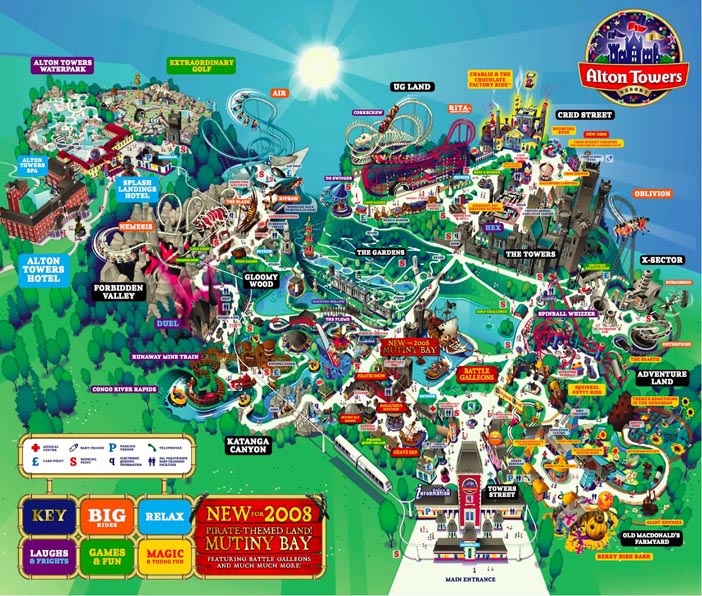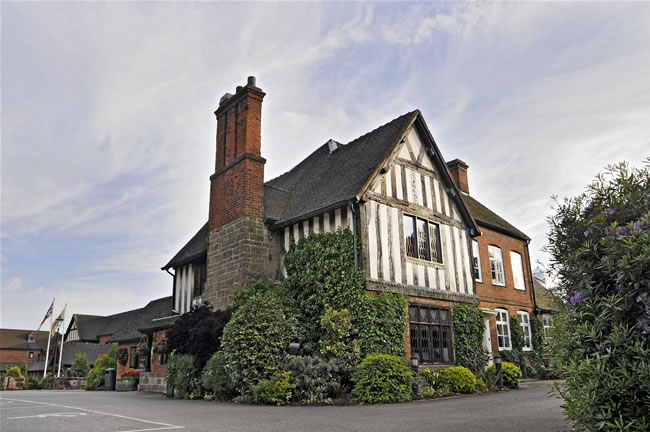|
Comparing real world customer journey’s with the web experience equivalent |
||||||||
In the UK this weekend it was a bank holiday, and my partner's birthday, so we set off to a local(ish) amusement park, called Alton Towers.
There is a rather handy map that you are given when you buy your tickets, and you are ushered through the front gates to be surrounded by souvenir shops and restaurants. After walking through a few areas of trinket sellers and the usual teddy merchants I began to notice how everyone was being 'funnelled' into handy areas of commerce. It is very subtly done, but to get to any of the themed areas of the park you have to pass several eating establishments, and child friendly games, where you can win stuffed animals that will never fit in your car.
Combine that with the idea that any ride you go on is surrounded by similarly themed merchandising opportunities, and once you have managed to damage all your internal organs from being shaken around 360 degrees, the exit to each ride is through a shop. You actually have to exit the queue to leave the ride by going through a shop.
This has to be one of the best most direct examples of meticulously plotting of the customer journey that I have ever seen. In most wire framing and spec analysis meeting it is always a consideration how an end-user is going to travel through your site. Usually you give them easy access to a variety of options so that they find using your applications hassle free, and painless. Rarely ever do you so carefully craft a path through your application as I witnessed in Alton Towers.

It was certainly an interesting comparison between the real-world customer journey, and the online equivalent. I know I'll certainly be taking a lesson or two from their example next time I am wire framing up a site layout.
|
The MoatHouse – Acton Trussell in Staffordshire |
||||||||
On a recent bank holiday weekend I had the luck to pick this hotel as part of a last minute (.com) break. I can say that it was one of the nicest hotels that I've ever stayed in, spacious rooms, great scenery, and the menu was fantastic.
They make a point of mentioning the restaurant quite a lot on their site, and it's definitely worth it. My partner and I had probably one of the best cooked traditional English style meals we have had. It's not cheap, nor what you would say expensive, but the quality is great!
So go here, and eat things.
|
Securing your release code with the compile command |
||||||||
In this article I examine the compilation feature of ColdFusion, and explore why you would want to do this to your release code.
A project that I worked on in the recent past was being hosted on a remote server, which was being supervised by a third party company. We were still responsible for the code base and suspected that some 'hot fixes' had gone in as live code changes implemented on the server.
Obviously this is not ideal, the sanctity of your code base is paramount, and if it is your responsibility you have to be absolutely sure you know what it contains, especially if there are tinkerers.
Another good use for this functionality is where you are selling the software as a service (SAAS). The normal occurrence here is that the client is renting or leasing the functionality of your application, not the actual code base itself. So a good way to deter them from peeking under the hood is to compile it.
2
3d:\cfusionmx7\wwwroot d:\cfusionmx7\wwwroot\appsRoot d:\cfusionmx7\wwwroot\AppsRootcompiled
In the code above the first line executes the cfcompile command, using the –deploy switch. This tells the compilation engine to take the source directory (the second line) and compile it, and move it into the destination directory (the third line). Be careful not to specify the same directories here, as it will flip out. Also there is a chance it will overwrite your source dir, which is bad as you cannot undo this.
The destination directory should now contain an exact copy of your code base, but compiled. Open a file it looks like garbage, but works exactly like the original.
Note that Compiling is different from Encrypting. With encryption you can decrypt the code base, as long as you know the seed, or hash. Compilation is irreversible, you cannot un-compile it, so be careful with your original un-compiled code base!
|
My Brute flash game |
||||||||
A work colleague sent me a link to this site today:
It is a great little flash game where you make a character, and fight them in an arena. It is all statistics based rather than 'action', but you soon get attached to the little chaps.
Give it a try, fight me in the Arena!










